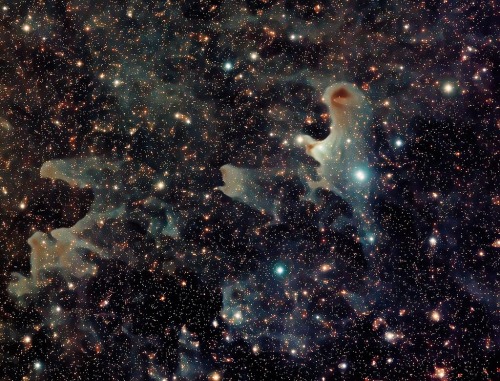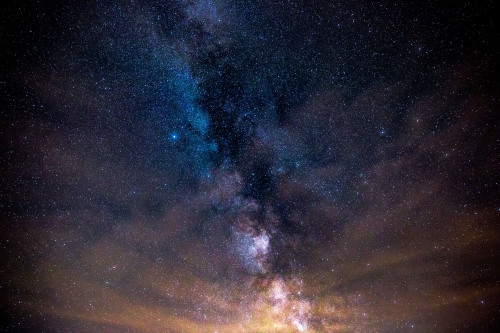Uranus’ Icy Moon Miranda Wowed Scientists During The Voyager Encounter With Its Dramatically Fractured

Uranus’ icy moon Miranda wowed scientists during the Voyager encounter with its dramatically fractured landscapes.
via reddit
More Posts from Littlecadet-biguniverse and Others
Just so you know, you can always watch the Earth live from the ISS. Its really relaxing to me


Jupiter’s North Pole Unlike Anything Encountered in Solar System
NASA’s Juno spacecraft has sent back the first-ever images of Jupiter’s north pole, taken during the spacecraft’s first flyby of the planet with its instruments switched on. The images show storm systems and weather activity unlike anything previously seen on any of our solar system’s gas-giant planets. “First glimpse of Jupiter’s north pole, and it looks like nothing we have seen or imagined before,” said Scott Bolton, principal investigator of Juno from the Southwest Research Institute in San Antonio. “It’s bluer in color up there than other parts of the planet, and there are a lot of storms. There is no sign of the latitudinal bands or zone and belts that we are used to – this image is hardly recognizable as Jupiter. We’re seeing signs that the clouds have shadows, possibly indicating that the clouds are at a higher altitude than other features.”
Credit: NASA/JPL-Caltech/SwRI/MSSS

Charon and Pluto: Strikingly Different Worlds
js

VdB 141 Region Nebulosity by Jeffrey Weiss on Flickr.

NGC 2736: The Pencil Nebula
js


M8 - Lagoon Nebula Up Close
June is “Lagoon Month” from my latitude. The June and July New Moons will be dedicated to photographing this photogenic nebula. I have booked a camping trip in early June, so I should be able to start capturing some more photons then! :) Here’s my version with limited exposure time from 2013.

ESO 540-030

Milky Way js

The violent past of our galaxy’s black hole could help us solve a cosmic mystery
The supermassive black hole at the center of our galaxy is pretty quiet now, but new research suggests that 6 million years ago it was raging and gobbling up matter. Scientists think it could explain a mysterious disappearance.
Follow @the-future-now
-
 bikerdude51 liked this · 6 years ago
bikerdude51 liked this · 6 years ago -
 lollipops-and-candy-canes-blog1 liked this · 7 years ago
lollipops-and-candy-canes-blog1 liked this · 7 years ago -
 lutefisk-kingdom liked this · 7 years ago
lutefisk-kingdom liked this · 7 years ago -
 mswscw-blog liked this · 7 years ago
mswscw-blog liked this · 7 years ago -
 judyrbullock liked this · 7 years ago
judyrbullock liked this · 7 years ago -
 laeastronomy reblogged this · 7 years ago
laeastronomy reblogged this · 7 years ago -
 dragonthc liked this · 7 years ago
dragonthc liked this · 7 years ago -
 delightfullyuniquecreation-blog liked this · 7 years ago
delightfullyuniquecreation-blog liked this · 7 years ago -
 ashismybop-blog liked this · 7 years ago
ashismybop-blog liked this · 7 years ago -
 eusakills reblogged this · 8 years ago
eusakills reblogged this · 8 years ago -
 slytherinawayfromyou reblogged this · 8 years ago
slytherinawayfromyou reblogged this · 8 years ago -
 emmaleighg13-blog liked this · 8 years ago
emmaleighg13-blog liked this · 8 years ago -
 struggling-photographer liked this · 8 years ago
struggling-photographer liked this · 8 years ago -
 earthlingalmond liked this · 8 years ago
earthlingalmond liked this · 8 years ago -
 beejweir liked this · 8 years ago
beejweir liked this · 8 years ago -
 okanogan reblogged this · 8 years ago
okanogan reblogged this · 8 years ago -
 meet-me-under-the-electric-sky liked this · 8 years ago
meet-me-under-the-electric-sky liked this · 8 years ago -
 sidekicksister reblogged this · 8 years ago
sidekicksister reblogged this · 8 years ago -
 megapurplebouquetninjafan liked this · 8 years ago
megapurplebouquetninjafan liked this · 8 years ago -
 youraveragepun liked this · 8 years ago
youraveragepun liked this · 8 years ago -
 theplanetarysystem liked this · 8 years ago
theplanetarysystem liked this · 8 years ago -
 elpeladorojo liked this · 8 years ago
elpeladorojo liked this · 8 years ago -
 nopedesg reblogged this · 8 years ago
nopedesg reblogged this · 8 years ago -
 nopedesg liked this · 8 years ago
nopedesg liked this · 8 years ago -
 youngjinpark02 liked this · 8 years ago
youngjinpark02 liked this · 8 years ago -
 farahhbatiikhii-blog liked this · 8 years ago
farahhbatiikhii-blog liked this · 8 years ago -
 angeluscaligo reblogged this · 8 years ago
angeluscaligo reblogged this · 8 years ago -
 ayamix3 liked this · 8 years ago
ayamix3 liked this · 8 years ago -
 ksuperidot213-blog liked this · 8 years ago
ksuperidot213-blog liked this · 8 years ago -
 th0ca liked this · 8 years ago
th0ca liked this · 8 years ago -
 kawaiimittenz-blog liked this · 8 years ago
kawaiimittenz-blog liked this · 8 years ago -
 angeluscaligo liked this · 8 years ago
angeluscaligo liked this · 8 years ago -
 vadasvadas-blog liked this · 8 years ago
vadasvadas-blog liked this · 8 years ago -
 marutour-blog liked this · 8 years ago
marutour-blog liked this · 8 years ago -
 divine-demigods reblogged this · 8 years ago
divine-demigods reblogged this · 8 years ago -
 witchofpearl reblogged this · 8 years ago
witchofpearl reblogged this · 8 years ago -
 witchofpearl liked this · 8 years ago
witchofpearl liked this · 8 years ago -
 fedthebeast liked this · 8 years ago
fedthebeast liked this · 8 years ago -
 infinitetheoriesofanxiety reblogged this · 8 years ago
infinitetheoriesofanxiety reblogged this · 8 years ago -
 thearspoetica liked this · 8 years ago
thearspoetica liked this · 8 years ago -
 outtrider reblogged this · 8 years ago
outtrider reblogged this · 8 years ago -
 semiotomatics liked this · 8 years ago
semiotomatics liked this · 8 years ago
GREETINGS FROM EARTH! Welcome to my space blog! Let's explore the stars together!!!
144 posts
